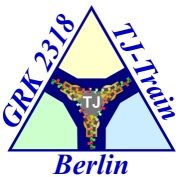
DFG Research Training Group "TJ-Train" (GRK 2318/2)
Tight junctions and their proteins
Molecular features and actions in health and disease
Project
Familial hypomagnesaemia with hypercalciuria and
nephrocalcinosis (FHHNC) is a deleterious rare autosomal-recessive renal tubular disorder caused by mutations in
the CLDN16 or CLDN19 gene encoding the tight junction proteins Claudin-16 and Claudin-19. The
disorder is characterized by renal wasting of calcium and magnesium and ultimately results in chronic kidney
disease. Mouse models with deletion of the murine homologue Cldn16 as already established by our group
display hypomagnesemia and hypercalciuria but no nephrocalcinosis or renal insufficiency.
We hypothesize that lower urinary pH in mice is
protecting the mice from nephrocalcinosis. Therefore, we will generate a mouse model that lacks additionally
Atp6v1b1, a gene encoding a proton pump and involved in renal pH regulation. We will investigate if the
elevated urinary pH will result in nephrocalcinosis. The resulting mouse model will help to understand the severe
progression of the disorder in patients.
Mutations in CLDN10 result in a multiplex
epithelium disorder characterized by hypohidrosis, electrolyte imbalance, lacrimal gland dysfunction, ichthyosis,
and xerostomia and designated 'HELIX syndrome'. Mice lacking claudin-10 specifically in the thick ascending limb
display impaired renal salt handling reflected by hypermagnesemia und nephrocalcinosis. The nephrocalcinosis,
which is not seen in patients, is presumably caused by calcium precipitation as consequence of a hyperresorption
of calcium.
We aim at investigating the nature of the
nephrocalcinosis as well as the precise localization. In combination, both models will help us to elucidate how
hyper- and hyporesorption of divalent cations result in nephrocalcinosis.
Methods
The deletion of Atp6v1b1 will be achieved by
CRISPR/Cas mediated genomic engineering in Cldn16 -/-
zygotes. The PhD student will perform a detailed biochemical as well as
histological analysis of these mice. If present, the nephrocalcinosis will be analyzed by dispersive X-ray. This
method will also be applied in the analysis of the claudin-10 deficient mice. Based on the results, the PhD
student will develop strategies to ameliorate the nephrocalcinosis and influence thereby CKD.
Suggested reading: See Project-related publications,
especially Refs. 4, 5, 7, and 11
3rd cohort PhD doctoral student
Marah Alhabahbeh


2nd cohort PhD doctoral student
Amr Al-Shebel


2nd cohort MD doctoral student
Laura Kröhn


1st cohort PhD doctoral student
Murat Seker

17.12.2021: Doctoral examination passed,
"The role of Cyclin and CBS Domain Divalent Metal Cation Transport Mediator 2 (CNNM2) in transepithelial magnesium
transport"
-
Franken GAC*, Seker M* (*shared first authorship),
Bos C, Siemons LAH, van der Eerden BCJ, Christ A, Hoenderop JGJ, Bindels RJM, Müller D, Breiderhoff T, de Baaij JHF (2021) Cyclin M2 (CNNM2) knockout mice show mild hypomagnesaemia and
developmental defects.
Sci. Rep.
11(1): 8217. doi: 10.1038/s41598-021-87548-6. (IF
5.0)
-
Seker M, Fernandez-Rodriguez C, Martinez-Cruz LA, Müller D (2019) Mouse models of human claudin-associated disorders:
benefits and limitations. Int. J. Mol. Sci. 20(21): 5504 (19 pages) [Pubmed] [WebPage]
[PDF] (Review)
(IF 4.6)
Project-related publications
-
Corral-Rodríguez MA, Stuiver M, Abascal-Palacios G, Diercks T, Oyenarte I, Ereño-Orbea J, Ibáñez De Opakua A, Blanco FJ, Encinar
JA, Spiwok V, Terashima H, Accardi A, Müller D, Martinez-Cruz LA (2014) Nucleotide binding triggers a conformational change of the CBS module of the magnesium transporter CNNM2 from a
twisted towards a flat structure. Biochem. J.
464: 23-34
-
Kooij G, Kopplin K, Blasig R, Stuiver M, Koning N, Goverse G, van der Pol SM, van Het Hof B, Gollasch M, Drexhage JA, Reijerkerk A,
Meij IC, Mebius R, Willnow TE, Müller D, Blasig IE, de Vries HE (2014) Disturbed function of the blood-cerebrospinal fluid barrier aggravates neuro-inflammation.
Acta Neuropathol.
128: 267-277
-
de Baaij JH, Stuiver M, Meij IC, Lainez S, Kopplin K, Venselaar H,
Müller D, Bindels RJ, Hoenderop JG (2012) Membrane topology and intracellular processing of cyclin M2 (CNNM2). J. Biol.
Chem.
287: 13644-13655
-
Breiderhoff T, Himmerkus N, Stuiver M, Mutig K, Will C, Meij IC, Bachmann S, Bleich M, Willnow TE, Müller D (2012)
Deletion of claudin-10 (Cldn10) in the thick ascending limb impairs paracellular sodium permeability and leads to hypermagnesemia and nephrocalcinosis.
Proc. Natl. Acad. Sci. USA
109: 14241-14246
-
Stuiver M, Lainez S, Will C, Terryn S, Günzel D, Debaix H, Sommer K, Kopplin K, Thumfart J, Kampik NB, Querfeld U, Willnow TE,
Němec V, Wagner CA, Hoenderop JG, Devuyst O, Knoers NV, Bindels RJ, Meij IC, Müller D (2011) CNNM2, encoding a basolateral protein required for renal Mg 2+
handling, is mutated in dominant hypomagnesemia.
Am. J. Hum. Genet.
88: 333-343
-
Milatz S, Krug SM, Rosenthal R, Günzel D, Müller D, Schulzke JD, Amasheh S, Fromm M (2010) Claudin-3 acts as a sealing
component of the tight junction for ions of either charge and uncharged solutes.
Biochim. Biophys. Acta
1798: 2048-2057
-
Will C, Breiderhoff T, Thumfart J, Stuiver M, Kopplin K, Sommer K, Günzel D, Querfeld U, Meij IC, Shan Q, Bleich M, Willnow TE,
Müller D (2010) Targeted deletion of murine Cldn16
identifies extra- and intrarenal compensatory mechanisms of Ca2+
and Mg2+
wasting. Am. J. Physiol. Renal Physiol.
298: F1152-F1161
-
Günzel D, Stuiver M, Kausalya PJ, Haisch L, Hunziker W, Krug S, Meij IC, Fromm M, Müller D (2009) Identification and
characterization of six novel claudin-10 splice variants. J. Cell Sci.
122: 1507-1517
-
Thumfart J, Jung S, Amasheh S, Krämer S, Peters H, Sommer K, Biber J, Murer H, Meij IC, Querfeld U, Wagner CA, Müller D
(2008) Magnesium stimulates renal phosphate reabsorption. Am. J. Physiol. Renal Physiol.
295: F1126-F1133
-
Müller D, Kausalya PJ, Claverie-Martin F, Meij IC, Eggert P, Garcia-Nieto V, Hunziker W (2003) A novel mutation in
claudin-16 associated with childhood hypercalciuria abolishes binding to ZO-1 and leads to lysosomal mistargeting.
Am. J. Hum. Genet.
73: 1293-1301
-
Jeroen H. F. de Baaij, Joost G. J. Hoenderop, René J. M. Bindels (2014) Magnesium in man: Implications for health
and disease.
Physiol. Rev. 95: 1-46
|
